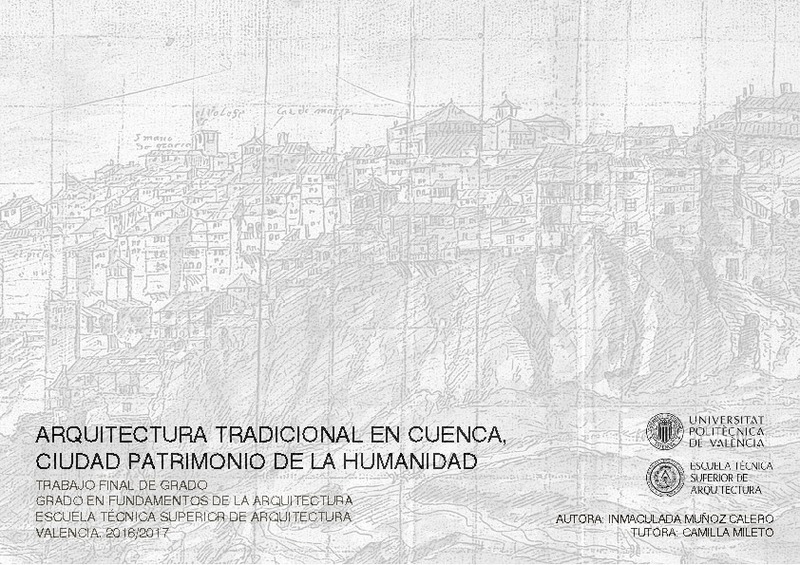JavaScript is disabled for your browser. Some features of this site may not work without it.
Buscar en RiuNet
Listar
Mi cuenta
Estadísticas
Ayuda RiuNet
Admin. UPV
Arquitectura tradicional en Cuenca, ciudad Patrimonio de la Humanidad
Mostrar el registro sencillo del ítem
Ficheros en el ítem
| dc.contributor.advisor | Mileto, Camilla
|
es_ES |
| dc.contributor.author | Muñoz Calero, Inmaculada
|
es_ES |
| dc.coverage.spatial | east=-2.1374161999999615; north=40.0703925; name=Conca, Cuenca, Espanya | es_ES |
| dc.date.accessioned | 2018-05-25T13:56:37Z | |
| dc.date.available | 2018-05-25T13:56:37Z | |
| dc.date.created | 2017-07-14 | |
| dc.date.issued | 2018-05-25 | es_ES |
| dc.identifier.uri | http://hdl.handle.net/10251/102663 | |
| dc.description.abstract | [ES] La fusión entre arquitectura y su entorno natural hacen merecedora a la ciudad de Cuenca de su declaración como Patrimonio Mundial en 1996 por la Unesco. La "Ciudad Alta" de Cuenca es concretamente la que obtiene dicho reconocimiento, su arquitectura tradicional, sus calles, sus pasadizos entre las viviendas y en definitiva, su Casco Antiguo, transmiten la forma de vida de hace siglos, la necesidad de adaptarse al escarpe de los ríos y "colgar" parte de su arquitectura ante la falta de espacio en el interior de las murallas. Tan importante es valorar lo que queda en pie, como conocer lo que un día hubo y su destrucción, muchas veces sin sentido, y establecer cómo actuar hoy para legar este Patrimonio Cultural a generaciones futuras. En el siguiente trabajo, se establece cómo Cuenca pasa a formar parte del Grupo de Ciudades Patrimonio de la Humanidad, los trámites, su declaración y su compromiso a partir de ese momento. Por otro lado, dentro de la provincia de Cuenca se analizan las diferentes tipologías edificatorias populares, con especial interés en la capital y se explica de forma más profunda la evolución de las Casas Colgadas como exponente y más reconocido ejemplo de su arquitectura tradicional, a pesar de los grandes cambios sufridos a lo largo de tiempo. | es_ES |
| dc.description.abstract | [EN] The fusion between architecture and its natural environment make the city of Cuenca to deserve the declaration as World Heritage in 1996 by Unesco. Is specifically, the "Ciudad Alta" of Cuenca the object of this recognition. Is the traditional architecture, the streets, the passageways between houses and, definitely, its Old Town, which transmit the way of life centuries ago, the need to adapt to the high rugged terrain and "hang" part of the architecture in the absence of space inside the city walls. Not only is important to value what remains, but also knowing what there was before and its destruction, often without sense, and establish how should we act to bequeath this Cultural Heritage to future generations. The following study states how Cuenca begins to take part of the Group of World Heritage Cities, the procedures and its declaration and commitment since that moment. Furthermore, the study analyses the different typologies of popular construction in the province of Cuenca, with a particular interest in the capital, and the evolution of the Hanging Houses as the greatest and more recognized example of traditional architecture, despite the changes that have taken place over time. | es_ES |
| dc.format.extent | 104 | es_ES |
| dc.language | Español | es_ES |
| dc.publisher | Universitat Politècnica de València | es_ES |
| dc.rights | Reserva de todos los derechos | es_ES |
| dc.subject | Popular Architecture | es_ES |
| dc.subject | Hanging Houses | es_ES |
| dc.subject | World Heritage | es_ES |
| dc.subject | Unesco | es_ES |
| dc.subject | Patrimonio Mundial | es_ES |
| dc.subject | Casas Colgadas | es_ES |
| dc.subject | Arquitectura Popular | es_ES |
| dc.subject.classification | COMPOSICION ARQUITECTONICA | es_ES |
| dc.subject.other | Grado en Fundamentos de la Arquitectura-Grau en Fonaments de l'Arquitectura | es_ES |
| dc.title | Arquitectura tradicional en Cuenca, ciudad Patrimonio de la Humanidad | es_ES |
| dc.type | Proyecto/Trabajo fin de carrera/grado | es_ES |
| dc.rights.accessRights | Abierto | es_ES |
| dc.description.bibliographicCitation | Muñoz Calero, I. (2017). Arquitectura tradicional en Cuenca, ciudad Patrimonio de la Humanidad. http://hdl.handle.net/10251/102663 | es_ES |
| dc.description.accrualMethod | TFGM | es_ES |
| dc.relation.pasarela | TFGM\63852 | es_ES |
Este ítem aparece en la(s) siguiente(s) colección(ones)
-
ETSA - Trabajos académicos [4439]
Escuela Técnica Superior de Arquitectura






